Want to add a Pink Princess Philodendron to your houseplant collection? They are beautiful and easy to care for! Here's my complete Pink Princess Philodendron care guide!
Are you looking for a pink houseplant to add to your collection? Look no further than the Pink Princess Philodendron!
Not only are they stunning, but they are also super easy to care for.
In this comprehensive guide, we'll walk you through everything you need to know to keep your Pink Princess Philodendron thriving and beautiful.
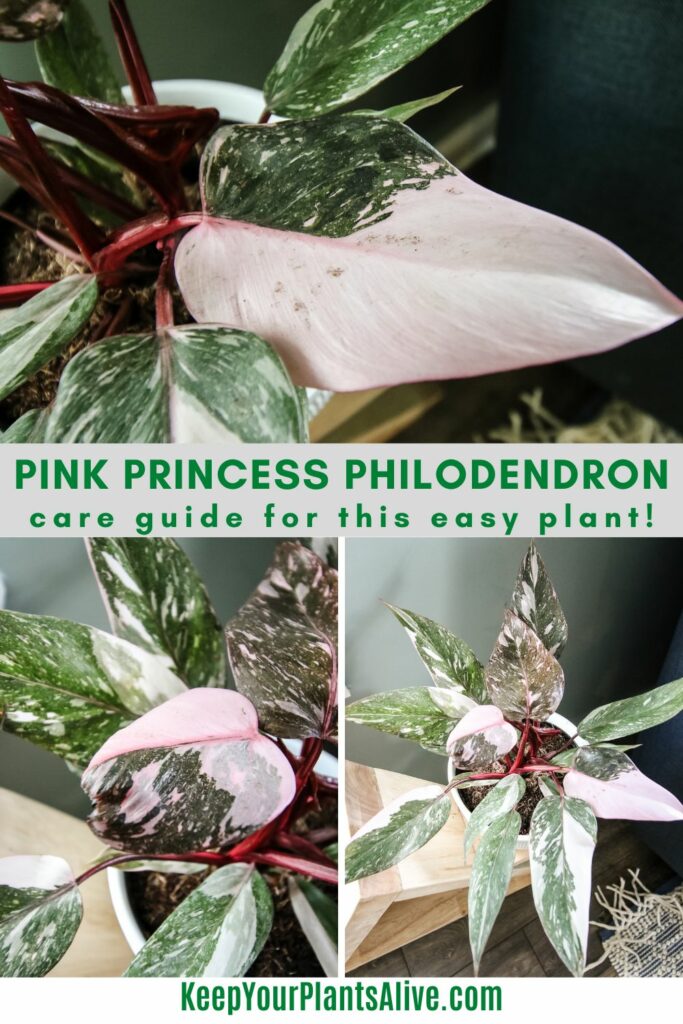
What is Pink Princess Philodendron?
Pink Princess Philodendron, also known as Philodendron erubescens, is a striking and sought-after houseplant loved for its heart-shaped leaves with vibrant shades of pink, green, and black.
Its unique pink foliage makes it a favorite among plant enthusiasts, adding a pop of color to any room.
Alternative names for the Pink Princess Philodendron include:
- Philodendron 'Pink Princess'
- Pink Congo Philodendron
- Pink Philodendron
- Philodendron erubescens 'Pink Princess'
- Blushing Philodendron
- Pink-Leaf Philodendron
- Pink-Variegated Philodendron
Pink Princess Philodendron Origins
Native to the tropical regions of South America, particularly Brazil, Pink Princess Philodendron thrives in warm and humid environments.
Its important to understand its natural habitat to get insights into its care requirements, so you can recreate those conditions indoors.
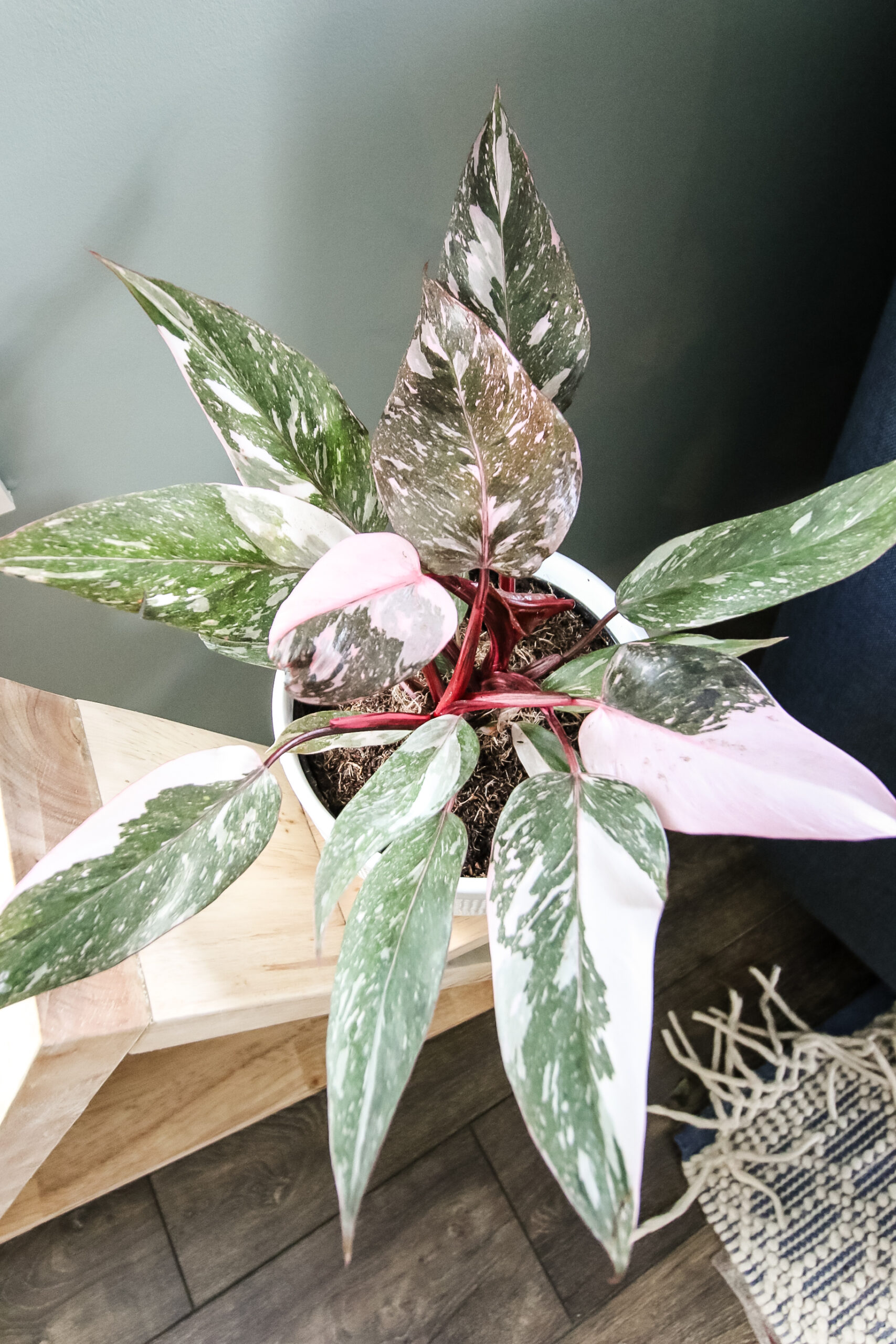
Is Pink Princess Philodendron Rare?
While Pink Princess Philodendron is highly desirable, it's not necessarily rare. They used to be more rare a year or two ago, but now I see them even at Lowes and Home Depot.
I actually ordered my plant from Costa Farms - on Amazon! A great use of an Amazon gift card, if I do say so myself, and it arrived in perfect condition.
The variegated varieties with more intense pink coloring can be a bit harder to find and may come at a higher price.
Is Pink Princess Philodendron Toxic?
Yes, Pink Princess Philodendron is toxic to humans and pets if ingested. It contains calcium oxalate crystals, which can cause discomfort and irritation if consumed.
So, it's important to place your Pink Princess Philodendron in a location that's out of reach for children and pets.

Pink Princess Philodendron Care Guide
Here is everything you need to know about caring for a Pink Princess Philodendron.
Pink Princess Philodendron Watering
Proper watering is crucial for the health of your Pink Princess Philodendron.
First of all, make sure your plant's pot has drainage holes. If not, consider reading our guide on drilling drainage holes in pots to ensure your Pink Princess Philodendron doesn't have pooling water in the pot, which can lead to root rot.
How often should I water my Pink Princess Philodendron?
Pink Princess Philodendron prefers evenly moist soil. Water your plant when the top inch of the soil feels dry to the touch.
Be mindful not to let it sit in very wet soil, as this can lead to root rot. Having proper drainage holes in your pot will allow excess water to drain away and prevent pooling water.
Should I mist my Pink Princess Philodendron?
While Pink Princess Philodendron appreciates humidity, misting might not be necessary if you provide adequate moisture through regular watering.
However, if your home has low humidity, misting occasionally can benefit your plant. Also consider running a humidifier or using a pebble tray to increase humidity around your plant!
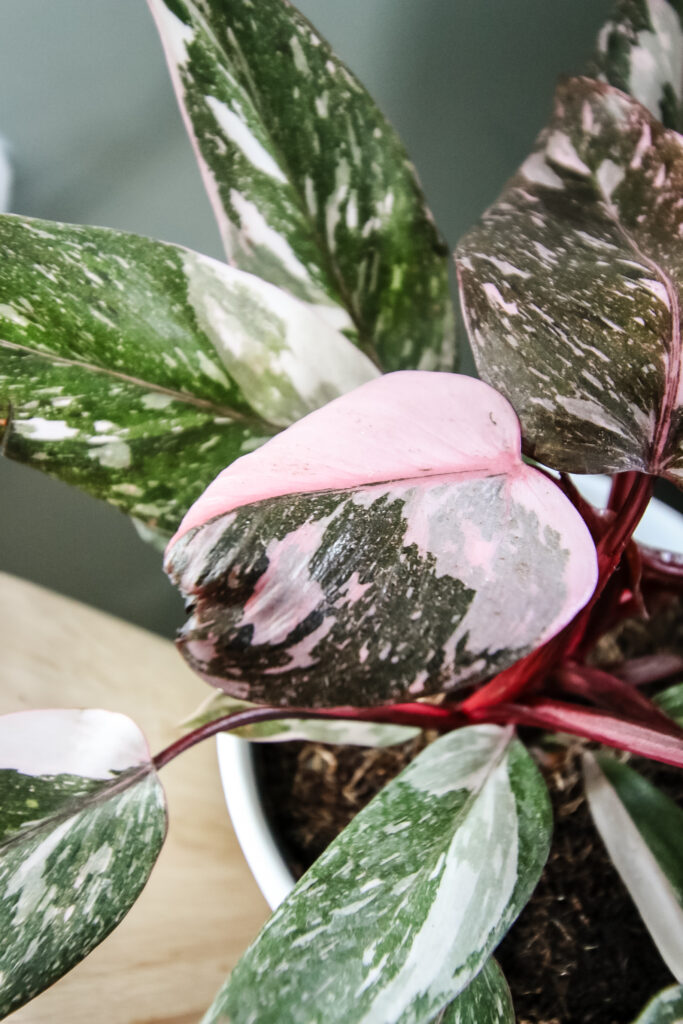
Pink Princess Philodendron Lighting Needs
Pink Princess Philodendron thrives in bright, indirect light. Avoid exposing it to direct sunlight, as this can scorch its leaves.
Place your plant near a window with sheer curtains or in a spot where it receives filtered sunlight.
If natural light is limited, you can also consider using artificial grow lights to supplement its lighting needs.
Can I Keep Pink Princess Philodendron Outdoors?
Pink Princess Philodendron is best suited for indoor environments, as it thrives in stable conditions.
Avoid placing it outdoors, especially in regions with extreme temperature fluctuations. Keeping it indoors ensures a healthier and happier plant.
If you do decide to move the plant outdoors, keep it out of direct sunlight and move it in when overnight temperatures drop below 50 degrees F!
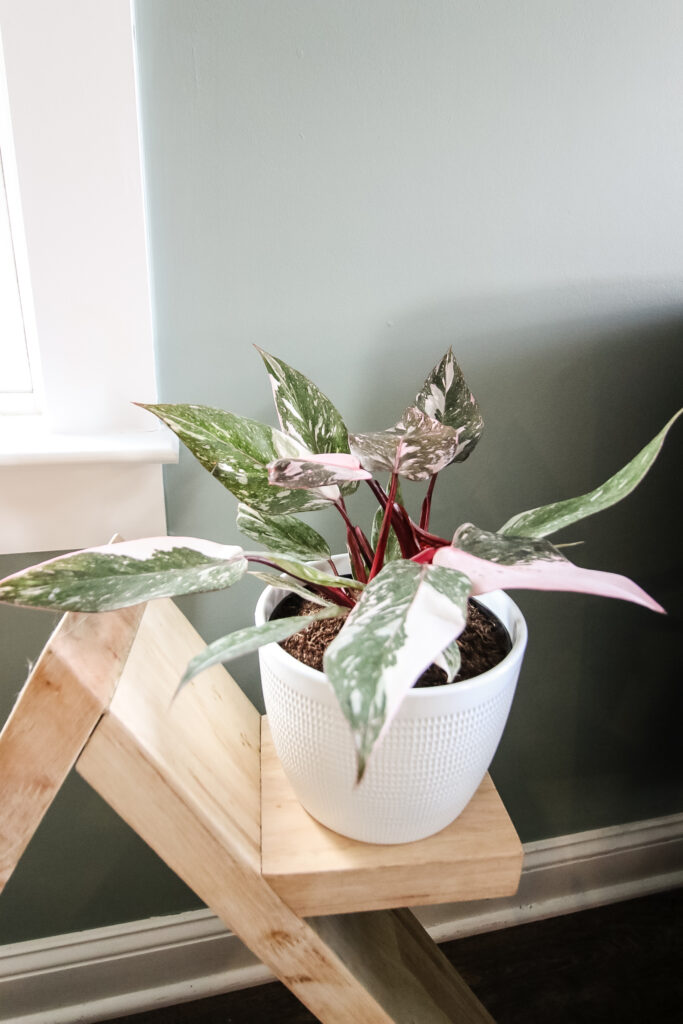
Pink Princess Philodendron Soil + Potting
Selecting the right soil is crucial for the health and vitality of your Pink Princess Philodendron. Opt for a well-draining, lightweight potting mix that retains some moisture while allowing excess water to escape.
A mix specifically designed for tropical plants works exceptionally well, ensuring the roots have access to the oxygen they need to thrive.
As your Pink Princess Philodendron grows, it will need repotting every 1-2 years, typically in spring. This process allows the plant to have fresh soil and ample space for root expansion.
Choose a pot that is 1-2 inches larger in diameter than the current one, ensuring it has drainage holes to prevent water-logging.
Does Pink Princess Philodendron like to be root bound?
While Pink Princess Philodendron doesn't mind a slightly snug pot, it's essential to repot it when it becomes root-bound. Repotting every 1-2 years allows your plant to have fresh, nutrient-rich soil and ample space for its roots to grow.
Does Pink Princess Philodendron need a moss pole?
Pink Princess Philodendron appreciates climbing structures like moss poles, which mimic its natural habitat where it grows on trees.
Providing a moss pole gives your plant the support it needs to grow vertically, creating a stunning display of cascading leaves.
Check out our guide on how to make a moss pole to enhance your Pink Princess Philodendron's growth.
Pink Princess Philodendron Fertilization
During the growing season (spring and summer), feed your Pink Princess Philodendron with a balanced liquid fertilizer every 4-6 weeks.
Dilute the fertilizer to half its recommended strength to prevent over-fertilization, which can harm your plant.
Avoid fertilizing during the winter months when the plant's growth slows down.
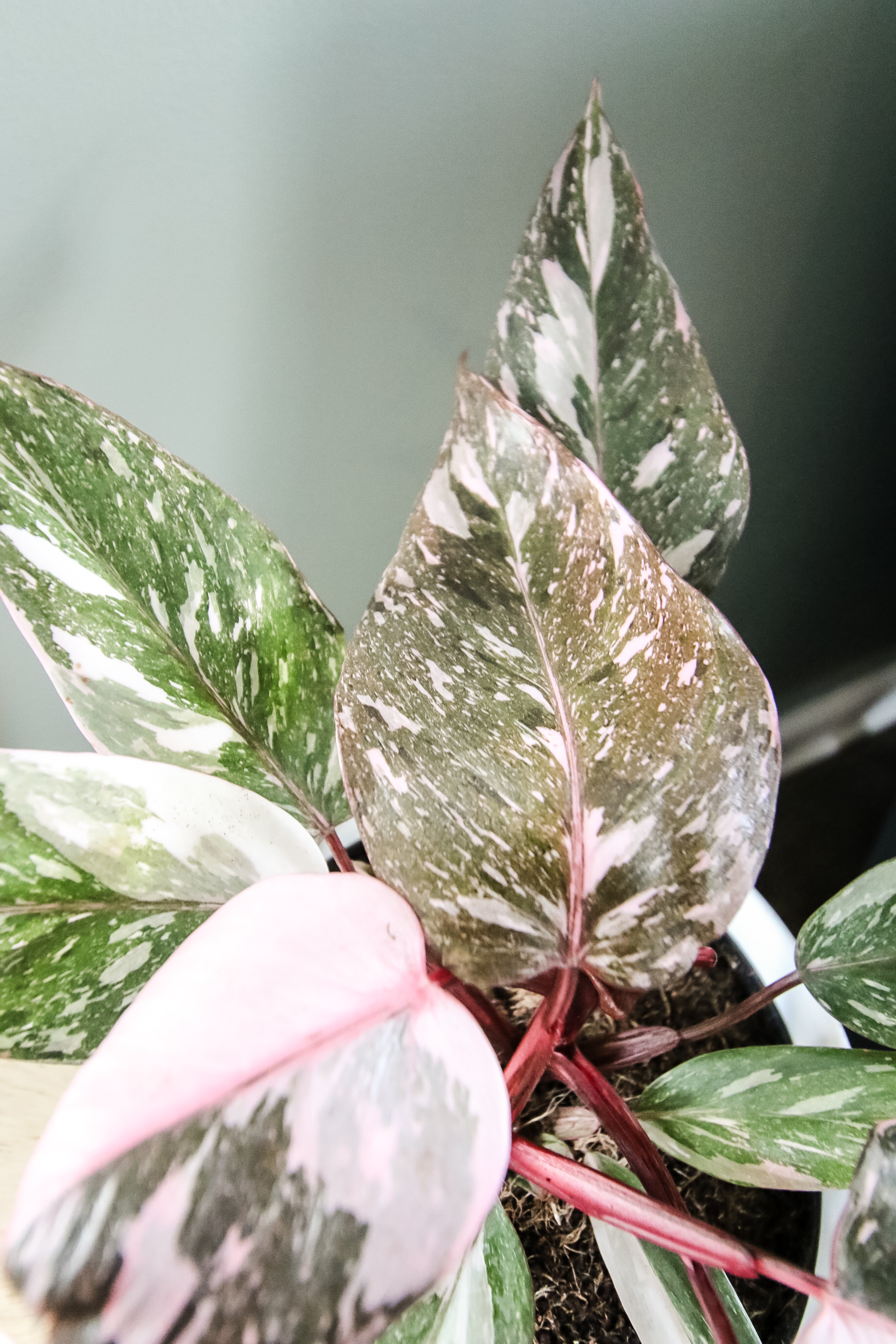
How to Propagate Pink Princess Philodendron
One of the best parts of Pink Princess Philodendron care is propagation, which allows you to share the beauty of your plant with others. They are easy to propagate!
Here's a simple method to propagate your Pink Princess Philodendron in water:
- Identify a healthy branch, preferably with new growth.
- Snip the branch with sharp scissors, ensuring it has at least 1-2 nodes.
- Remove any lower leaves that would fall under the water line (leaves tend to rot and gunk up the water).
- Place the cutting in a jar of water, making sure the nodes are all underwater.
- Change the water once a week and top it off as necessary.
- In 2-4 weeks, you'll notice roots starting to form.
- Once the roots are 2-3 inches long, plant the cutting in soil and treat it like a new Pink Princess Philodendron!
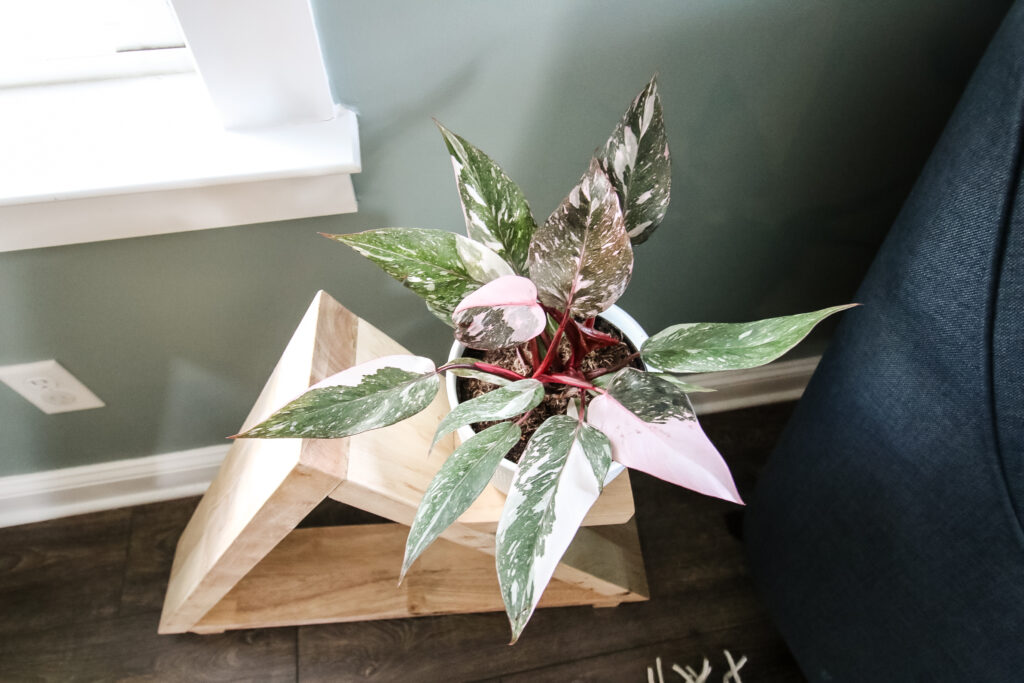
Troubleshooting Pink Princess Philodendron
Here are some common Pink Princess Philodendron problems and how to solve them!
My Pink Princess Philodendron's leaves are turning yellow. What am I doing wrong?
Yellow leaves can indicate overwatering or underwatering. Ensure you're following the watering guidelines mentioned earlier.
Additionally, check if your plant is receiving appropriate light – too much direct sunlight can scorch the leaves. If the issue persists, inspect the roots for signs of root rot and consider repotting if necessary.
How often should I prune my Pink Princess Philodendron?
Regular pruning is essential to maintain the plant's shape and encourage new growth. Trim leggy stems and cut back dead leaves as needed, preferably in spring or early summer when the plant is actively growing.
What should I do if my Pink Princess Philodendron's leaves are losing their variegation?
Variegation loss can occur due to insufficient light. Move your plant to a brighter spot with indirect sunlight to help preserve its vibrant colors.
Ensure it receives adequate but filtered light to maintain its striking appearance.
Here are all of our tips for how to care for variegated plants!
How can I prevent pests like spider mites and aphids on my Pink Princess Philodendron?
Regularly inspect your plant for signs of pests, such as webs, discolored leaves, or sticky residue. Wipe the leaves with a damp cloth to remove dust, which can attract pests.
For persistent infestations, consider neem oil or insecticidal soap as natural remedies.
Why are the edges of my Pink Princess Philodendron's leaves turning brown?
Brown leaf edges often indicate low humidity levels. Increase humidity around your plant by misting it occasionally, placing a humidifier nearby, or grouping it with other plants. Also, ensure you're watering the plant adequately to prevent dehydration.
My Pink Princess Philodendron is wilting despite regular watering. What could be the issue?
Wilting can be a sign of both overwatering and underwatering. Check the soil moisture level; if it's consistently wet, reduce watering frequency. If it's dry, increase watering slightly.
The leaves of my Pink Princess Philodendron are drooping. What might be the cause?
Drooping leaves can indicate underwatering or root issues. Check the soil moisture and adjust your watering routine if needed. If the roots are healthy, consider providing a supportive stake to help the plant stand upright.
My Pink Princess Philodendron's growth has slowed down significantly. What should I do?
Slow growth can result from various factors, including insufficient light, outdated soil, or lack of nutrients. Ensure your plant is receiving adequate indirect sunlight, consider repotting if it's been a while, and feed it with a balanced liquid fertilizer during the growing season.
Can I propagate my Pink Princess Philodendron in soil instead of water?
Yes, Pink Princess Philodendron can be propagated in soil. Follow the same steps for taking a cutting but directly plant the cutting in a well-draining potting mix.
Ensure the soil stays consistently moist until roots develop, usually within a few weeks. I like to cover my plants loosely with a clear bag when rooting to create a greenhouse effect!
Want more easy care plants?
Check out some of my favorite plant care guides:
Thanks for reading!


Hey there, I'm Morgan, a houseplant enthusiast from sunny Charleston, South Carolina. Growing up surrounded by my mom's lush orchids and African violets, I discovered the magic of bringing nature indoors. Thanks to the pandemic, I delved deeper into houseplants, discovering their power to uplift moods and transform spaces. I'm here to spill all my secrets, helping you pick the perfect houseplant - and make it happy. Let's keep your plants alive, together! 😊
